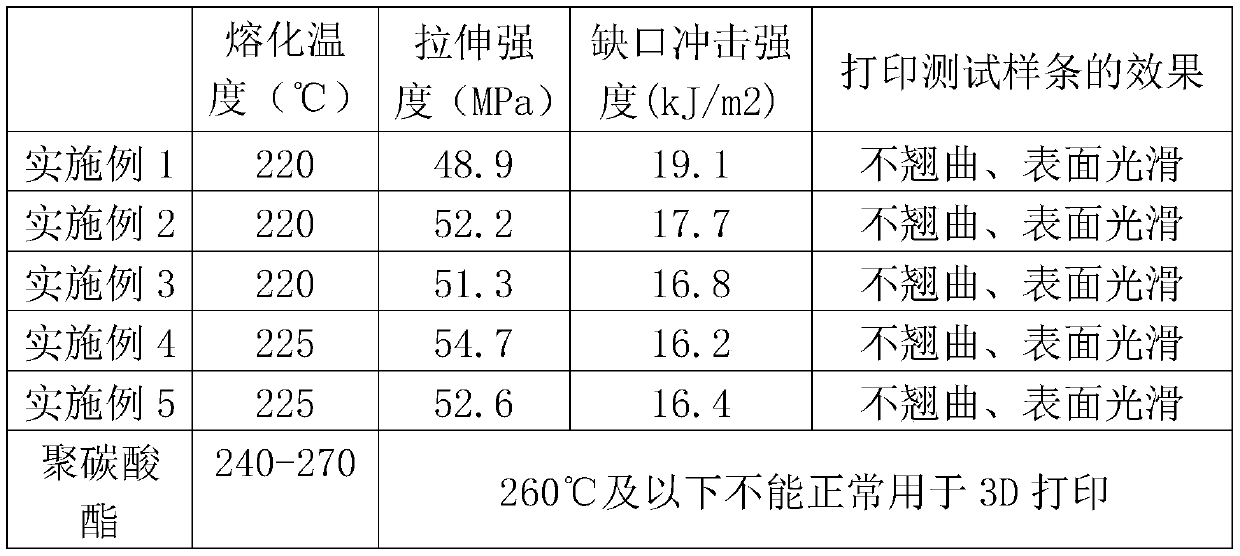A kind of preparation method of modified polycarbonate material for 3D printing
A polycarbonate and 3D printing technology, used in additive processing and other directions, can solve the problems of warpage and deformation of printed products, and the inability to print and form polycarbonate materials, so as to improve processing performance, reduce warpage and cracking, and achieve good results. The effect of mechanical properties
- Summary
- Abstract
- Description
- Claims
- Application Information
AI Technical Summary
Problems solved by technology
Method used
Image
Examples
Embodiment 1
[0035] This embodiment provides a method for preparing a modified polycarbonate material for 3D printing, comprising the following steps:
[0036] Dry the polycarbonate at 110°C until the water content does not exceed 0.05%, then cool to room temperature for later use;
[0037] Weigh out the following raw materials in weight parts: 100 parts of general polycarbonate, 20 parts of polycaprolactone, 10 parts of toughening agent, 0.5 part of hindered phenolic antioxidant, 0.2 part of phosphite antioxidant, and The weighed components were stirred and mixed at a speed of 400r / min for 10 minutes to obtain premixed raw materials; the general-purpose polycarbonate was selected from Covestro XT5010, the polycaprolactone selects Capa TM 6500, the toughening agent is methyl methacrylate-styrene-butadiene core-shell copolymer, and the hindered phenolic antioxidant is β-(3,5-di-tert-butyl-4-hydroxybenzene Base) octadecyl propionate, the phosphite antioxidant is three [2,4-di-tert-butyl...
Embodiment 2
[0041] This embodiment provides a method for preparing a modified polycarbonate material for 3D printing, comprising the following steps:
[0042] Dry the polycarbonate at 100°C until the water content does not exceed 0.05%, and then cool it to room temperature for later use;
[0043] Weigh out the following raw materials in parts by weight: 100 parts of general-purpose polycarbonate, 10 parts of thermotropic liquid crystal polymer, 25 parts of polycaprolactone, 12 parts of toughening agent, 2 parts of hydrophobic fumed silica, hindered phenolic anti- 0.3 part of oxygen agent, 0.2 part of phosphite antioxidant, and mix the weighed components at a speed of 100r / min for 20 minutes to obtain premixed raw materials; the general-purpose polycarbonate is Chimei PC- 122, the thermotropic liquid crystal polymer is Celanese A950, the polycaprolactone selects Capa TM 6506, the toughening agent is methyl methacrylate-styrene-butadiene core-shell copolymer, and the hydrophobic fumed ...
Embodiment 3
[0047] This embodiment provides a method for preparing a modified polycarbonate material for 3D printing, comprising the following steps:
[0048] Dry polycarbonate at 120°C until the water content does not exceed 0.05%, then cool to room temperature for later use;
[0049] Weigh out the following raw materials in parts by weight: 80 parts of general-purpose polycarbonate, 20 parts of disc grade polycarbonate, 5 parts of thermotropic liquid crystal polymer, 15 parts of polycaprolactone, 8 parts of toughening agent, hydrophobic gas phase dioxide 2 parts of silicon, 0.5 part of hindered phenolic antioxidant, 0.2 part of phosphite antioxidant, and each weighed component was stirred and mixed at a speed of 600r / min for 15 minutes to obtain a premixed raw material; General polycarbonate chooses Covestro 2405, the disc grade polycarbonate is Covestro CD2005, and the thermotropic liquid crystal polymer is Celanese A900, the toughening agent is methyl methacrylate-butyl acrylate ...
PUM
| Property | Measurement | Unit |
|---|---|---|
| melt flow index | aaaaa | aaaaa |
| melting point | aaaaa | aaaaa |
| melting point | aaaaa | aaaaa |
Abstract
Description
Claims
Application Information
 Login to View More
Login to View More - R&D
- Intellectual Property
- Life Sciences
- Materials
- Tech Scout
- Unparalleled Data Quality
- Higher Quality Content
- 60% Fewer Hallucinations
Browse by: Latest US Patents, China's latest patents, Technical Efficacy Thesaurus, Application Domain, Technology Topic, Popular Technical Reports.
© 2025 PatSnap. All rights reserved.Legal|Privacy policy|Modern Slavery Act Transparency Statement|Sitemap|About US| Contact US: help@patsnap.com

